Roland JD-XA Review
Andy Jones is the luckiest man in music technology, so does he really have to go on ‘that’ Roland rant again? Yes. He does. Here’s his review of Roland’s JD-XA… Details Price £1,599 Contact +44 (0) 1792 702701 Web www.roland.co.uk Those with a short attention span might want to skip the next couple of […]
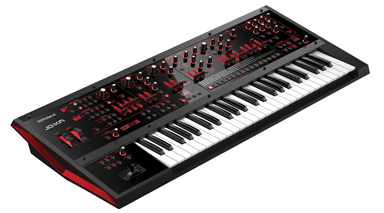
Andy Jones is the luckiest man in music technology, so does he really have to go on ‘that’ Roland rant again? Yes. He does. Here’s his review of Roland’s JD-XA…
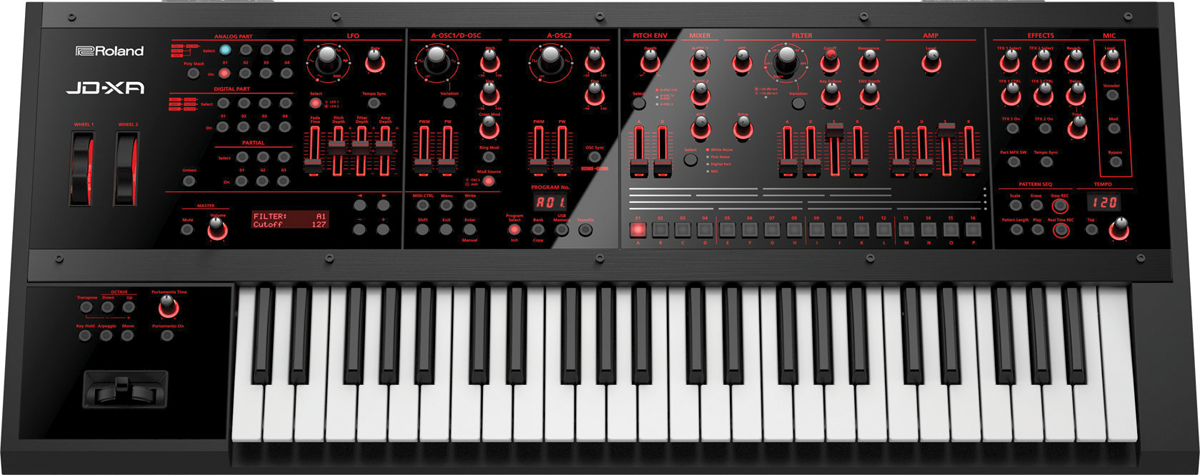


Details
Price £1,599
Contact +44 (0) 1792 702701
Web www.roland.co.uk
Those with a short attention span might want to skip the next couple of paragraphs, to the bit that I will probably start with “and now Roland could be brilliant again”. Because I always find that when writing about this particular company, lots of explanations are needed. And lots of adjectives…
As a music technology big gun, Roland has been one of the most brilliant and aggravating in music technology history. It released some of the finest synths to grace the planet, with the likes of the Jupiter 8 and Juno 60 in the 80s. Then, at the end of that decade, it inadvertently kicked off dance music with a bunch of old bass and drum machines (rediscovered, re-used and abused years after their original release by pioneering producers on both sides of the Atlantic).
For the next couple of decades, it floundered into trying to ignore computers while at the same time eventually realising what it had done in dance music and trying to cash in with instruments your dad might like.
That’s ‘might’. But then, last year, Aira – ahhhh sweet Aira – signified a return. Of sorts. It was a secret project to start with, but seems to have broken a huge damn of creativity at the Japanese giant, and now we’re inundated with product release after product release, to the point where Roland actually won the show-stopping headlines at the recent major trade shows (whereas at one time we weren’t sure if they were even at these trade shows).
And Now Roland could be brilliant again…
…and here’s where we welcome back some readers. So, to Roland today, and we’re talking about a company that has come to terms with its past (both Aira TR-8 and TB-3 do justice to the original machines); a company embracing analogue as never before (the forthcoming System 500 is my most anticipated release of the year); a company embracing the burgeoning modular synth community as if it is part of that community (we’ve had a demo of the new Aira effects modules and they look and sound pretty awesome); and a company that has even embraced computer music making (I never thought I’d say that, but System-1 could be seen as basically a controller for a bunch of superb soft synths).
I’ve also just realised that Roland makes me use a lot of italics. But as if all the above (bar the italic bit) is not enough, Roland could be making fantastic synths again.
I say ‘could’… After that fanfare of an intro, it would be easy for me to say, yes, Roland’s doing that, too, and lead into another glorious review of its latest kit but, well, you’ve guessed it, this is Roland. The JD-Xi was the big return to synths, and the last Roland gear that I tested, but it was not without its faults.
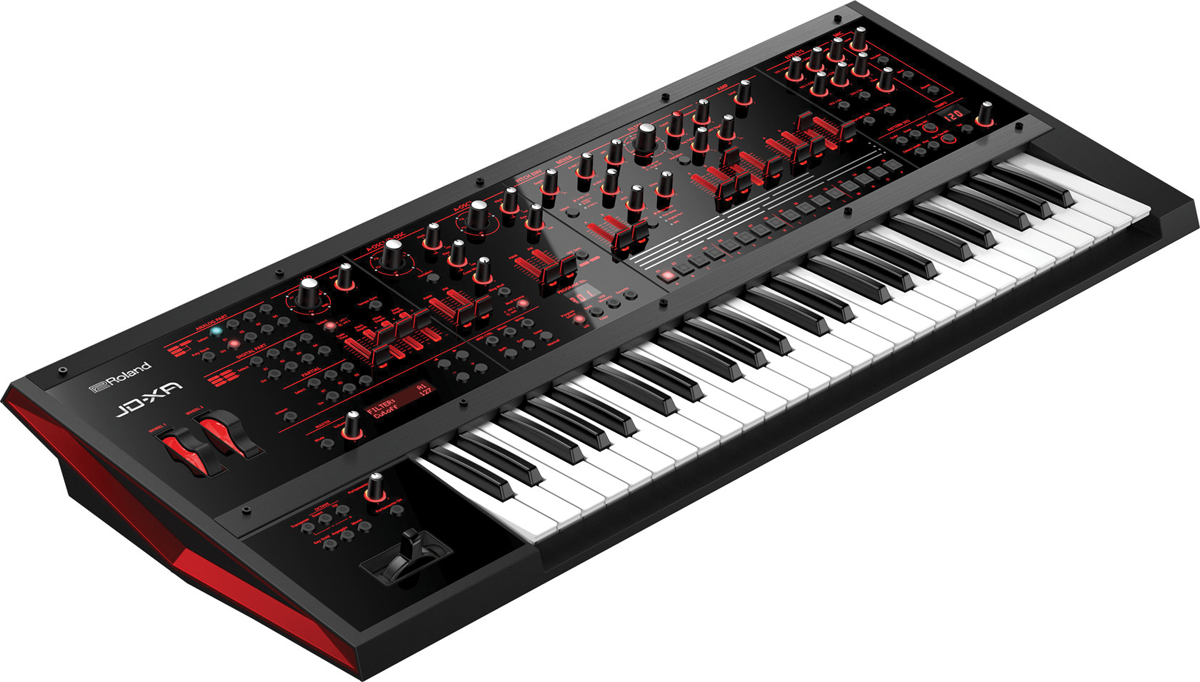
This is what all the fuss was about at NAMM 2015, but was the JD-XA synth worth keeping a secret?
It sounded great, was analogue and digital, but built as if it was designed for EDM users (and probably loved by them). Fortunately, while the JD-XA is related in the ‘JD’ sense of the name, this one’s built for their dads, and not in the embarrassing dad dance way of Roland products from 1998 to 2012.
What They Share
The JD-XA does, of course, share features with its smaller brother, the JD-Xi, but when you get into the detail it’s more about an overall concept that they share rather than too much of the depth. Yes, both are analogue/digital ‘Crossover’ synths and, yes, the digital side of the JD-XA is again represented by Roland’s long-standing SuperNatural technology. They also share a glowing fascia, well-lit front panels being de rigour for any item of studio technology these days (which gets my vote).
But whereas the ‘i’ was monophonic on the analogue side, the ‘A’ has four parts, which can each be monophonic or combined for up to four notes of polyphony.
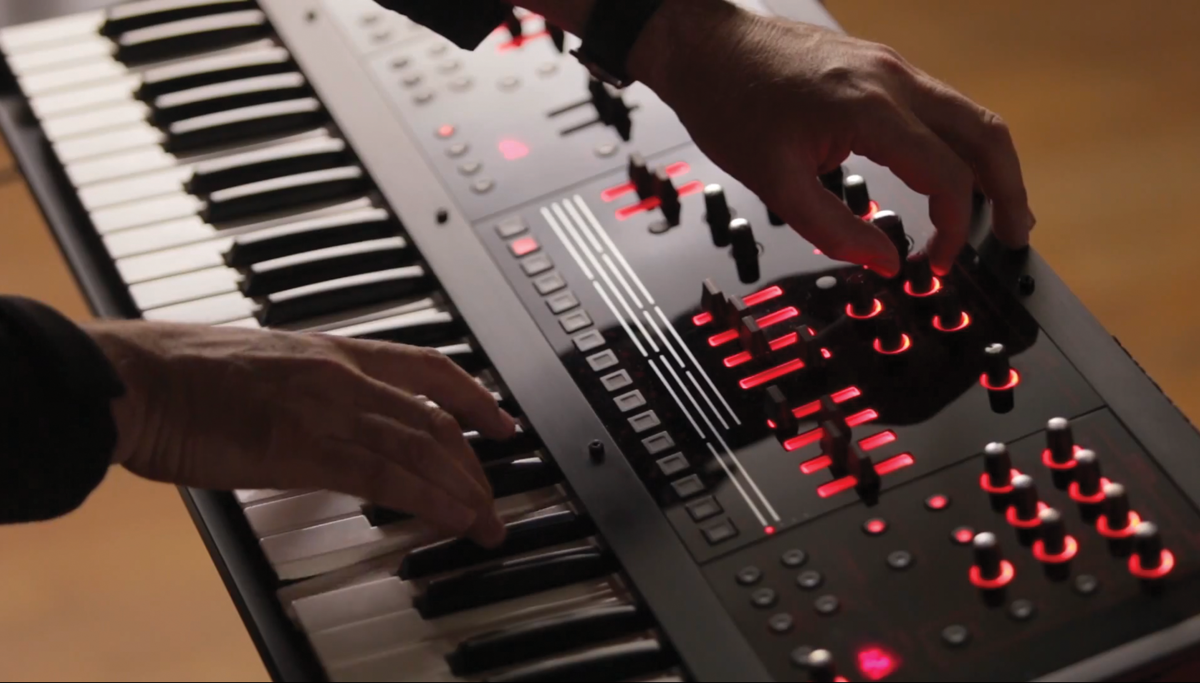
The main knobs and sliders are backlit, in a way we now expect from our gear
And, going further, the analogue element on the larger synth is not the same, boasting dual oscillators and a drive rather than the i’s sub oscillator. Other elements, too, are skewed slightly between the two; so it would probably be unfair to consider, for example, the JDX-A as being simply ‘the JD-Xi times four’.
Indeed, there are many marked differences, and it also transpires that Roland doesn’t particularly want you to think of them as brothers, so I’m going to shelve the comparisons for now and just look at the A on its own. I was getting sick of writing ‘i’ and ‘A’ anyway to be honest…
In Detail
We’ve explored some of the front-panel functions below, but broadly speaking, think of the bulk of the fascia as being taken up by the analogue synth controls and the bottom by common controls for Program selection and the onboard sequencer programming.
Interestingly, on the JD-XA you might find the contrast between these well-lit features to be a little high compared to the printed lettering on the unit itself, making the latter hard to read in certain light. Having all of that lettering lit as well would have been great, but perhaps a little too Christmassy…
On to the synth’s main architecture; think of a Program as an eight-part combination made of four analogue mono synths, which you can stack (but with default MIDI channels of 1 to 4), and four digital slots that take their sounds from the aforementioned SuperNatural engine. These have up to 64 voices of polyphony available between them, and by default are set on MIDI channels 5 to 8, so clearly these eight parts can be played as a performance (together) or a multi-timbral set-up (separately).

We would say it has the usual controls, and it does – but a lot more besides – pedals plus CV/Gate connections too.
With that in mind, we can look at how the Programs sound, and their constituent parts but, unlike the JD-Xi, it’s not so easy to get to the constituent parts of these Programs. The analogue sounds can’t be chosen from a list, for example, but the digital ones can be defined by their partials. Again, the thinking is that the XA is a grown-up version of the Xi, so where that synth had it laid out for you, the XA is more for people who want to create analogue sounds from scratch or use some of the Programs on offer.
The Programs
As far as these go, you can expect pretty much something of everything, but if I were to try to sum it up, I’d use the word ‘big’. The biggest sounds, of course, utilise all eight parts of a Program, with either a big-sounding analogue half with four notes of polyphony, or four different analogue sounds stacked (or a mixture of these). Add four digital combinations with up to 64 notes and you’ll understand why I say ‘big’.
There’s lots of movement, too – flowing sweeps, dubsteppy basses, one-button-press soundscapes and simply loads of things right across the frequency spectrum.
As you would expect, the Roland programmers have played to the Crossover strengths, so where big booming bass is required they’ve layered punchy analogue sounds with fast attacks over droning sub basses and then brought in extra movement by way of the effects. In fact, talking of the programmers, what a palette they had, with so many engines and modifications at their disposal – and by and large, they do seem to have made the most of them.
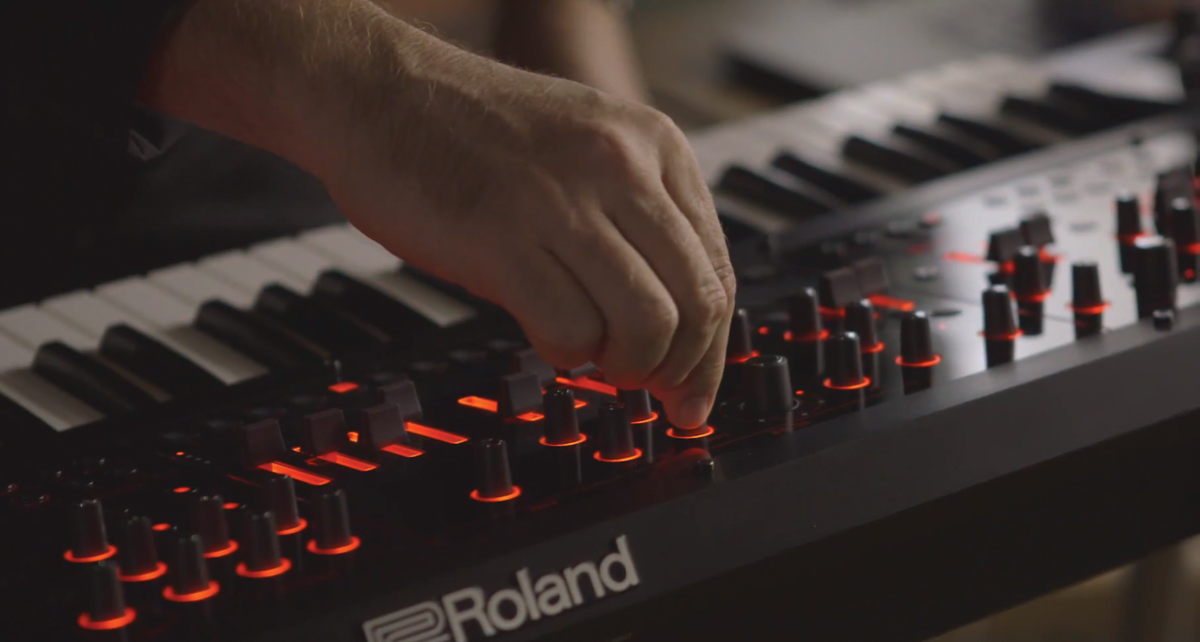
Who will benefit? Soundtrack and dance composers, for sure – there are lots of instant tunes in both camps. People used to the digital side of Roland synths – those sound modules and keyboards stacked full of both real and imaginary sounds – might be disappointed because there’s less acoustic stuff here. And thank the Lord – you can keep your fake trumpets and saxophones for another module, this is a synth that you get hands-on with, and dirty hands at that.
Which is the main point of it. The more than two dozen rotaries demand that you turn them, command you to change sounds and dream. You can create virtually anything you want with the ingredients Roland has given you, and then you can take them anywhere with the controls.
If you mess with just one in your first half-hour, make it the Drive control – as this will dirty up anything. The synth might have one of the cleanest and most shiny (and arguably a tad too plastic) front panels in synth design history, but the JD-XA’s got the potential for the dirtiest of sounds. It’s like meeting a nice lady at church, only to find that she talks like
a navvy and burps for her country.
Which brings us to the crux of the synth. The clue is in the word ‘Crossover’. Yes, we have a great analogue synth that you can layer up, or add polyphony onto one sound. And, yes, we have a great digital synth, with Roland’s Supernatural technology its well-tested backbone.
But the JD-XA is all about the two crossing over, so as well as that dirty drive, it’s about channelling the digital through the audio and adding warmth; it’s about blending the best analogue sounds with chiming digital cleanliness and creating something new out of it.
You can see examples in the videos online and witness how a straight-up, clean digital synth can produce a Blade Runner-esque sound that evokes the best in analogue; it’s these combinations and the possibilities they bring that really make the JD-XA synth so exciting.
Overview
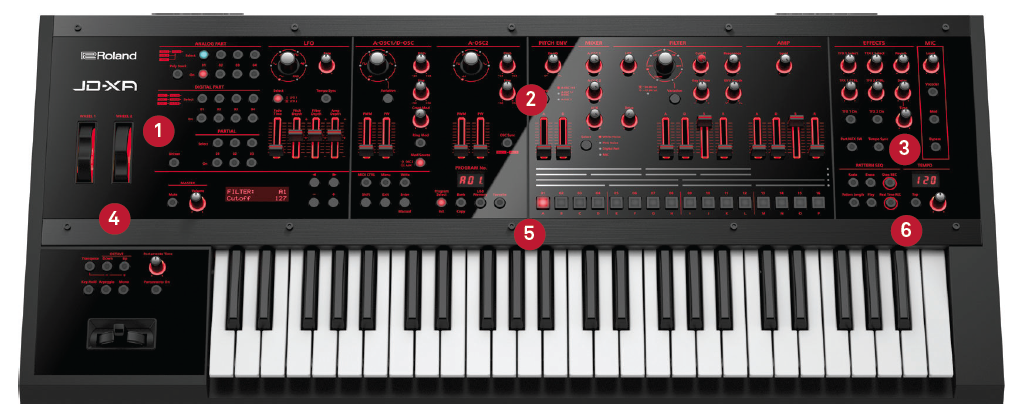
1: Part Selection – You choose – or can see – which of the eight parts is active within a Program. The top four are the analogue components, the bottom are the digital. Below this, you determine three partials that make up the digital sound.
2: Synth Controls – The biggest part of the front panel is the analogue (and digital) synth area, where the oscillators, mixer, filters and amp section are, along with four envelope sections. Each can also be accessed and changed via the screen.
3: Effects/Mic Sections – These include five system effects (reverb, TFX1, TFX2, delay and master EQ) for all parts, plus a Mic section. Here, you can modulate the synth sounds with your voice and vocode.
4: Common Section + Controllers – Main controls include volume, octave +/-, arp. and the main screen (and a + and – for stepping through parameters/presets). Also, pitch/mod and two programmable wheels, plus MIDI setup for ext. control.
5: Preset Selection – As well as the + and – detailed left, you can choose preset Programs via bank and number here, with 16 buttons that double up as the 16-track sequencer. Favourite Programs can also be selected here.
6: Pattern Sequencer and Tempo Controls – The main controls for the on-board sequencer are to the right of the 16 buttons that program them and determine scale, length and so on. There’s also a master tempo dial for a third display showing its value
Other Features
But there is more. You can use the JD as a fully-assignable MIDI controller for your DAW/plugs, or a high quality vocoder by connecting a mic. And the on-board sequencer is very useful and doesn’t add too much complexity. You might brush over this as – with each Program clearly created as an eight-part MIDI multi-timbral set-up – the synth certainly lends itself to being used with an external DAW. But the sequencer also reveals the synth’s Patterns which demand attention.

It’s a clean-looking synth, but don’t let that fool you. Getting hands-on with the JD-XA is where the synth’s real dirt lies. Use it in one of four ways. It has pure analogue (with a dedicated bus), it has digital, but mixing the two in a single Program, or routing digital waves through the analogue signal path is where you will add most interest. ‘Crossover’ equals mixing the two for the best results…
Essentially behind many – but not all – of the Programs lie Patterns, which you can trigger with the Play button. These Patterns are essentially cycling riffs (over the 16 parts) of notes, created over up to eight parts of a Program. You can easily record your own by playing notes in real time, or a couple of step time modes where you key in the notes using the 16 pads.
Importantly, both the effects and the Program’s sound parameters can be recorded so, for example, you can open up a filter on a sound while it cycles around and increase the amount of the effect you’re using.
When you consider that you can do this on all eight sounds that make up a Program within a Pattern Sequence, it suddenly becomes apparent that you have a powerful feature and one that, oops, like me, you might have up until that point avoided…
I’m not a huge fan of programming sequences of Patterns together like this when I have Logic to do that with, but once you give it a go you realise that you might not need that computer after all. It’s actually so easy that, as well as a scratch pad when you are alone and DAW-less, live players will love the ability to have programmed phrases and backing tracks at their disposal.
The arpeggiator is another JD feature worth touching on, again because it’s pretty easy to get in to and to make the best of. Simply hit the Arpeggiator button with any sound, then maybe the Key Hold and Shift>Arpeggiator, and you will be in its feature list to tweak Patterns. You’ll soon see how creative it can be, and it’s another good sonic feature.
Alternatives
As I suggest in the text below, the JD-XA’s price puts it in the big league of synths, with Moog, Dave Smith, Access, Nord and more hitting big in that zone. Of those, I’ve looked at the Nord Lead 4 (slightly cheaper at £1,350), which obviously does the virtual analogue thing well. With some digital wavetable synthesis, it also offers a bit of both worlds, although the clash between them isn’t as pronounced and it’s only over, essentially, four parts.
The Access Virus TI (£1,500+) is a synth I looked at seemingly ages ago, and is still around. It sounds incredible and also acts like a virtual instrument within your DAW, although by now I suspect it might be sounding just a little dated.
Other than that, there’s little in any price range that does digital and analogue so well, so if this is what you want – and especially if you are pushed for funds – you should check out the JD-Xi, even though they are surprisingly different in many ways. It’s light in weight but sounds good – not as good as the ‘A’, but it is a quarter of the cost.
A for Attainment?
So what do I think overall? The sound is a plus. I liked the JD-Xi’s sound. I love the JD-XA’s. It takes the concept of Crossover synthesis that you could argue the JD-Xi introduced, and runs with it to a much higher level. There are more parts, with which to make bolder sounds – and the engines to get you there are also bigger.
I also like many of the features, including the sequencer – it’s simple and surprisingly creative. I’m not saying I’d use it, but there’s no reason for it not to be there and not to use it as, at the very least, a notepad. I love the look of the synth, too. My studio is swimming in lights at the moment – it’s a personal thing, I know – but I’m very happy with that.
The negatives are fewer. I can live with the fact that you might have to squint to read some of the front panel – you’ll get used to what is where after a while. The partial analogue thing threw me a bit at first, but I can see why Roland has done it this way. I’d maybe have liked a bigger screen to incorporate colour and touch and lessen the need for three LEDs – but there again I have been spoilt this month by the screen on the new Akai Advance keyboard Yes, the plastic finish is still a little smooth and does tend to mark easily, but now I’m picking hairs.
That leaves the price. The full retail of £1,599 (currently £1,549 street) puts this synth close to synth super-league territory price-wise. It’s up there with models from the likes of Moog, Dave Smith, Nord and Access, all of whom have great reps and great machines.
You could argue, though, and I will, that while these synths have individual strengths, they focus mostly on specific sonic areas, whereas the JD-XA has two distinct territories in its Crossover architecture: analogue and digital.
Bizarrely, then, if you take this argument further, the one synth that does compete with it is the JD-Xi, which I moved away from, as it has some very big differences. And because of those differences, Roland doesn’t really want you perceive them as related, but they do share the Crossover architecture, so do have some similar sounds.
With the Xi streeting at just £379 you could, then, buy four for the price of one JD-XA… Food for thought… Would I, though? Well, with the extra muscle, bigger keys, the approach and the design, I think – even though I’m greedy and usually choose quantity over quality – this time I’d say less is more. It’s an A for me, and an A from me
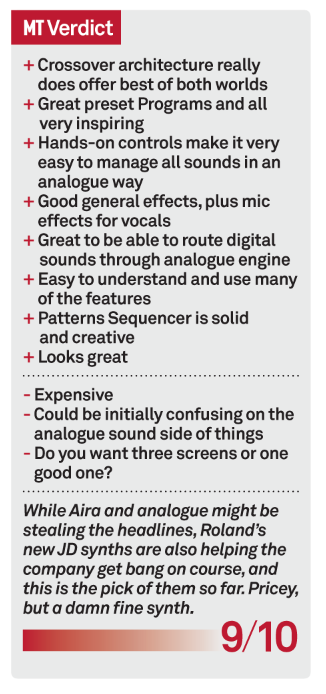
Key Features
● 49-key Crossover synth with analogue and digital synth engines
● Velocity sensitive with aftertouch
● 256 Programs, 8-part combos, sequences or arpeggios
● USB MIDI/audio with digital and analogue streaming to computer
● Analogue engine, 4-part multi and monophonic or up to 4-part polyphony at one instance
● 4-pole transistor ladder multi-mode filter
● Digital engine: SuperNatural sounds, up to 64 parts polyphony over four parts
● Digital sounds can be routed through analogue engine
● 5 system effects over 100 types
● 16-track sequencer (8 internal and 8 external)
● Connections inc. MIDI, USB, Gate + mic i/p for vocoder effects
● h x w x d (cm) = 11.1 x 90 x 39
● Weight (kg): 6.5


